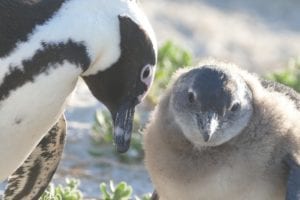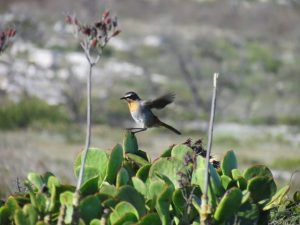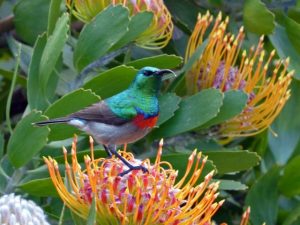Reluctant No Longer
By Eric Schroeder
It was the first day of my month-long program teaching University of California students in South Africa. I was leading a three-hour walking tour of downtown Cape Town and decided I’d better begin with one of the tougher parts of the program—introducing my students to the local birds. We had begun our walking tour at the Castle of Good Hope—the original Dutch fort and oldest building in South Africa, completed in 1679. The moats had been dry on my last visit two years earlier but had recently been refilled. The first moat was full of garbage—the students were really disgusted. But the second moat looked healthy—reeds were growing and there was almost no garbage. A quick flash of bright blue—a Malachite Kingfisher! Wow.
Never thought I’d see one of those in downtown Cape Town.
The program, called “City to Safari,” is a UC Davis Summer Abroad offering for which
students enroll in two 4-unit university courses. The first of these is African
American & African Studies (AAS) 157, “Literature and Society in South Africa”; the
second one is AAS 198, a group studies course that I design as a fieldwork course.
When I first starting leading it in 2001, my idea was to teach an interdisciplinary
program that would include not only South African literature and history (the focus
of the first course and my own field of study), but also politics, some anthropology,
and close observation of nature, such a key feature of South Africa.
This last goal, I reasoned, would be important to attract students to the
program—they would see lots of South African mammals and birds. In AAS 157, the
“classroom” course, students learn about South African history and politics and
literature, and their assessment would be based on three essays they would write
and a midterm exam. In the “field work” course students visit many of the places
they are reading about (like Robben Island, where Nelson Mandela spent 18 years in
prison) but they also explore several South Africa national parks and nature
reserves. For this course they are required not only to keep field journals about the
places they were seeing, but also to keep records of the mammals and birds they
observe. Their final essay exam would draw upon their work in both courses.
The mammals are an easy sell. All of the students want to see lions, leopards, rhinos,
elephants, zebras, giraffes, baboons—you get the picture—and they do see these,
and more (most students record between thirty and forty mammals for their month
in South Africa). But the birds are another matter. Aside from the ostrich and the
South African penguin, the students have little sense of South African birdlife—and
not a lot of interest in learning.

But I had a reason to hope that this summer (my ninth program) might not be quite
as challenging as previous ones. It seems that bird watching is growing in popularity
with young people. Bob Lewis, one of the co-instructors of the joint GGBA/California
Academy of Sciences Master Birder Program (MBP), had been telling me about four
young birders who had enrolled in the MBP that year. These students were
fledglings indeed—between the ages of 12 and 14—and all were doing well in the
program. In June the New York Times had featured a piece on “Young Urban Birders”
(or “yubbies” as the Times humorously had dubbed them.) The Times recounts how
young people use “social media to track their ornithological marks” and use Twitter
as their medium for bird alerts. The article’s author, Penelope Green, cites birding’s
appeal to this new audience “They are drawn in by the visual seductions of
Instagram, as well as a desire for community inflected by environmentalism.” Maybe
I can make this work for me, I thought.
The Malachite Kingfisher proved to be an excellent start. It helped that the bird was
colorful and that we found it in an unexpected place—downtown Cape Town. This
string of luck continued at the end of the week when we did our all-day field trip to
the Cape of Good Hope National Park (which is to Cape Town what Pt. Reyes is to
the Bay Area.) Entering the park we sighted a Rock Kestrel perched in a small tree by
the roadside. Minutes later we began seeing sunbirds. In South Africa sunbirds fill
the niche occupied by hummingbirds in the New World. Like our hummingbirds,
they are brightly colored, colors often contrasting, with long, curved bills. I thought
if anything could hook these students on birding, it would be these.
We had good looks at the Southern Double-collared Sunbird and a few students got
lucky and got an excellent look at another malachite bird, the Malachite Sunbird,
(Malachite is a bright-green mineral that lends its name to several bright-green
birds.) With its vibrant color and long tail the Malachite is perhaps the most striking
sunbird of all. Raptors and colorful birds—another good start.
The real test came a little later that morning when we stopped to sort out some LBJs.
These particular LBJs had a little bit of yellow in places, making me suspect they
were canaries. Canaries, particularly females, are hard. They are seedeaters and
comparable to our sparrows. We spotted one in the top of a tall shrub, and several of
the keener students discussed it with me and decided it was a female Yellow Canary.
I was impressed with the way they had meticulously examined their field guides.

On the same day we saw the expected Ostriches and then made the pilgrimage to
Boulders Beach to view the penguin colony there. Seeing these iconic birds helped
the students who were still struggling with bird watching. Or most of them, at any
rate. Several days later students had to turn in their journals for the first time.
By and large I was impressed with the bird lists students had generated that first
week—the obvious birds mentioned above, but also some ones that students in the
past hadn’t gotten—Cape Spurfowl, Speckled Pigeon, Cape Robin-Chat. (Perhaps
they were inspired by my mention of prizes that would be given to those who
produced the best bird and mammal lists?)

I was equally impressed with what they had to say about the experience. Ezra, a
double major in English and history who had no experience birding before this
program wrote in his journal, “bird watching was honestly incredibly fun.” He went
on to note that he enjoyed the list-keeping aspect of the experience and the “puzzle”
of identifying new species, concluding, “It was thrilling every time I was able to
identify a bird, which in turn helped boost my confidence when it came to
identifying the next.”
One journal, however, gave me pause; Justice wrote, “I’m sorry for the shortness of
this list—I really tried (for a few days). Signed, Your Reluctant Birder.” I realized,
however, that I had to cut her some slack—Justice was a terrific student but birding
just wasn’t her thing.
In the meantime, the larger part of the group seemed to have embraced birding. Our
next field trip was to Kirstenbosch Botanical Garden and, although it was intended
as an introduction to the flora of South Africa, I had encouraged students to bring
their binoculars since the garden is a local birding hotspot. Once again, the sunbirds
made an appearance. They were upstaged, however, by a pair of Cape Sugarbirds,
the male of which has a tail that the field guide describes as varying “considerably in
length”—anywhere from one-and-a-half to three times its body length. “What the
heck is THAT?” a student exclaimed when the birds were first sighted. Plants were
momentarily forgotten.

But the real breakthrough that day was when our guide, Senior Botanist Andrew
Jacobs (who knows I want students to learn about plants AND birds), spotted some
canaries on the trail ahead of us. He was excited since it was a mixed group of birds,
and he was able to explain the differences between the Yellow Canary, the Forest
Canary, and the Cape Canary. His enthusiasm was infectious and several of the
students set to work photographing these rather plain-looking birds.
A couple of days later, I got an email from Becca who was emerging as one of the
stars of this group—she wondered whether what we saw on the Cape of Good Hope
field trip was perhaps not a female Yellow Canary but rather a female Yellow
Bishop, a bird that closely resembles a canary. She had attached a photo—a good
one. I have learned recently that some younger birders prefer cameras to binoculars
as their preferred optics; I had originally cautioned this group that they should
consider using both.
But Becca was uncanny with her camera and generally preferred it to her
binoculars. Then she laid out her reasoning: according to the field guide’s
geographical distribution map, Yellow Bishops occurred at the Cape. The bird was in
the right habitat. I checked my own records. Years earlier I had seen a Yellow Bishop
at the Cape of Good Hope. And eBird showed lots of local sightings. But the clincher
for me was the photo. I was convinced. Later that evening I went on eBird and
corrected my list.
By the end of the second week of class I knew I was in trouble. A couple of days
before I had told a few of them about Rondevlei, a local wetlands I had been to some
years before, and said it was a great place to see all sorts of birds, particularly water
birds—ducks, waders, egrets. Becca and two other students, Ezra and Chelsea,
arranged transportation for themselves and went the next day, their day off from
class. When they returned they reported that they had each seen more than thirty
new species and their totals were now in the 70’s. Hmmmmm, I thought. I had been
on eBird the day before; my own total for the time in Cape Town stood at 71. I was
going to be outbirded by these rookies.
The real fun came in the final week. The name of the program is “South Africa: From
City to Safari” and for most of the program the city part is dominant, despite field
trips to places like the Cape of Good Hope, the top of Table Mountain, and
Kirstenbosch Gardens. We are in Cape Town for three weeks and Johannesburg for
two days. The last five days is the safari—one big field trip in the Karongwe Reserve,
a 28,000-acre private game reserve near South Africa’s famous Kruger National
Park—with an all-day excursion into Kruger itself.
Most of the students made a serious effort the last five days. And Becca, Chelsea, and
Ezra went flat out, each doubling his or her list. The all-day trip to Kruger Park was
particularly intense—I logged sixty species that day and afterwards I suspected that
those three students had each matched that number (or perhaps exceeded it!)
On the last day of the program I collected journals for the final time, reading the
students’ entries for that week and looking at their completed mammal and bird
lists. I was impressed. Over the past eight times that I’ve led this program I’ve
occasionally had a student or two who hit 100 bird species for the month—excellent
considering that all of my students begin the program as novice birders. This year I
had five students who tallied over 100 species; my three top birders were in the
stratosphere—Chelsea had 151 species, Ezra had 161, and Becca had 169. My
earlier intimation—that I was in trouble!—proved to be correct—I edged out Ezra
with 162 species but was bested by Becca. Novices indeed.
But my greatest pleasure in reading their final journals was Justice’s last entry. She
had a total of only 33 birds, broken into two lists. The first one contained 29 entries
and was marked “incomplete list.” The second list was labeled “Birds I identified on
my own.” Initially she hadn’t liked the competitiveness that some of the students
exhibited and was overwhelmed by the experience. She was also put off by the few
students who didn’t make an effort themselves but only relied on others—guides
and fellow students—to identify birds for them. During those final days in the
reserve she made a point of sitting in the safari vehicle with the motivated students.
She concluded, “OK, so I guess I don’t strongly dislike birding? Stumbling across the
bird and looking it up at my own pace, and because I wanted to, was fun! Unexpected,
but I am glad I did it. It was quite fun. Perfect mix between challenging and relaxing.
Yours truly, A former bird-watching slacker.”
Eric Schroeder worked at UC Davis where he had a thirty-year career as a lecturer and administrator. He taught for several departments—including the University Writing Program, the English Department, and the American Studies Program—and spent his last decade at UCD as the Director of Study Abroad for which he still leads summer programs in Australia, South Africa, and Scotland. His local volunteer work includes serving as president of the Tilden Wildcat Horseman’s Association for seven years and being a member of the East Bay Regional Park District’s Volunteer Mounted Patrol. He recently completed the Master Birder Program sponsored by GGBA and the Academy of Science.
